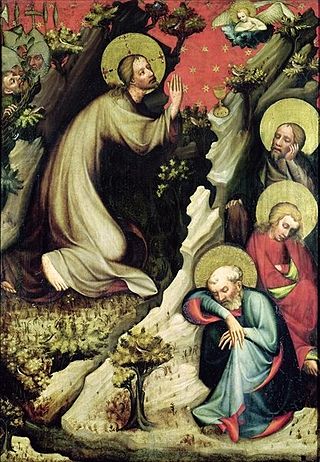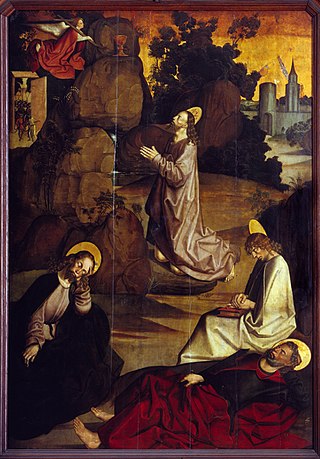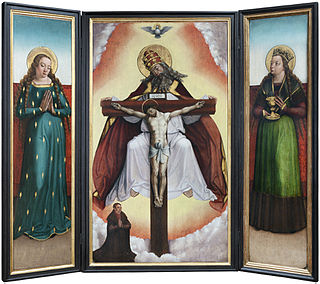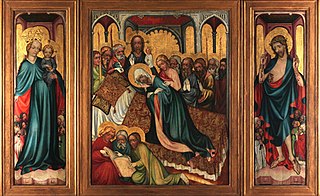
Matthias of Arras (c.1290–1352), sometimes spelled as Matthew of Arras was a French architect, famed for his work on St. Vitus Cathedral in Prague.

Master Theodoric, in Latin Magister Theodoricus was a Bohemian painter. He is the best documented Bohemian Gothic painter. He was the favourite court painter of Charles IV, Holy Roman Emperor. and the first Bohemian painter whose name can be linked to a body of work. Theodoric is considered the chief representative of the phase of International Gothic known as "the Soft style". His masterpiece is the Chapel of the Holy Cross at Charles' newly completed Karlštejn Castle, near Prague, containing a large series of slightly over-lifesize half-length panel portraits of saints and other notable figures on a gold ground. The whole decoration of the chapel was commissioned in 1359 and completed over a number of years. The decoration of the Chapel of the Holy Cross was unique and unprecedented at the north of the Alps. Theodoric's oeuvre is not comparable to anything in European art after the mid-14th century (1360th).
Master IW, also Monogramist I.W., was a Bohemian or Saxon Renaissance painter, trained in the workshop of Lucas Cranach the Elder, active between 1520 and 1550 mainly in north-west Bohemia.

The Votive Panel of Jan Očko of Vlašim is a Gothic panel painting now in the National Gallery in Prague, Czech Republic. It is one of the most important artworks made in medieval Bohemia. The panel was painted for the Prague archbishop Jan Očko of Vlašim who is depicted kneeling before St. Adalbert of Prague in the lower part of the picture. The author(s) of the painting is (are) not known. The style of the painting stands between the works of Theodoric of Prague and the Master of the Třeboň Altarpiece.

The Třeboň Altarpiece, also known as Wittingau altarpiece, is one of the most important works of European Gothic panel painting. Of the original large altarpiece retable created in about 1380 by an anonymous Gothic painter called the Master of the Třeboň Altarpiece, three wings, painted on both sides, have survived. The altarpiece is one of the works that helped towards the emergence of the International Gothic style and which influenced the development of art in a broad European context.

The St. Vitus Madonna comes from the treasure of St. Vitus Cathedral in Prague and is exhibited in its original frame in the permanent collection of the National Gallery in Prague.

The Death of the Virgin Mary of Košátky is a Bohemian panel painting from the period around 1340–1350.

Madonna Enthroned between St. Catherine and St. Elizabeth of Hungary is an icon, a central part of the side altar of the Church of the Nativity of the Virgin Mary in Jánovciach. The author of the original triptych, Master Martin, signed his name on the back of the icon, from 1497. The signature on the back of the board reads: Martin(us) 1497 Pictor in Vigilia Nativity (is). The patron of the icon is unknown.

The panel painting of The Madonna between St Catherine and St Margaret dating from the period before 1360 most probably formed the central part of a lost altarpiece in the Cistercian Abbey of Zlatá Koruna. It is a key work of early Bohemian Gothic painting. It is on display at the permanent collection of the Aleš South Bohemian Gallery in Hluboká nad Vltavou.

The Vyšší Brod (Hohenfurth) cycle, ranks among the most important monuments of European Gothic painting. It is made up of nine panel paintings depicting scenes from the Life of Christ, covering his childhood, Passion and resurrection. These paintings were made between 1345 and 1350 in the workshop of the Master of Vyšší Brod that was most probably based in Prague. The pictures were either meant for a square altar retable or else they decorated the choir partition of the church of the Cistercian Abbey in Vyšší Brod.

The Litoměřice Altarpiece (1505–1507) was a large altar retable, in all likelihood with two pairs of movable wings and two pairs of fixed ones. From these wings, six panels have survived, two of which are painted on both sides. The movable wings on the left-hand side of the altar are presumed lost. The altar wing depicting Christ on the Mount of Olives belongs to the Diocese of Litoměřice, while the other panels are owned by the Regional Museum in Litoměřice. It is the largest surviving set of panel paintings by an anonymous late Gothic and early Renaissance painter called the Master of the Litoměřice Altarpiece. The altarpiece is part of the permanent collection of the North Bohemian Gallery of Fine Art in Litoměřice.

The Altarpiece of the Holy Trinity is a work by the Master of the Litoměřice Altarpiece dating from c. 1520. It is on display in the permanent collection of the National Gallery in Prague.

Law and Grace is considered one of the most important paintings by Lucas Cranach the Elder. This work, in the collection of the National Gallery in Prague, is one of the two oldest known versions of this theme and was executed in 1529. It is also called the Prague type and provided the model for a series of other paintings including an early-16th-century copy that is also kept in the Prague National Gallery's collection of Old European art. It is the best-known and most influential allegory depicting the fundamental tenets of Luther's reform of the church.

The Winged Altarpiece of Our Lady from Seeberg is a Late Gothic altarpiece originally located in the Church of St Wolfgang in Seeberg. The sculptor, known as the Master of the Marian Altarpiece from Seeberg, received his training in the workshop of the Bavarian sculptor Hans Leinberger, and so the works of the two artists are similar in style and date from the same time. The workshop of the Master of the Marian Altarpiece from Seeberg was most probably located directly in Cheb, where it combined the local woodcarving tradition of the successful workshop of Hans Maler with the contemporary fashionable style of the Danube School. The altarpiece from Seeberg is one of the few outstanding works of Late Gothic sculpture to have been preserved in the Cheb region. It is displayed in the permanent exhibition of the Gallery of Fine Arts in Cheb.

Madonna of Žebrák is a fully sculpted Gothic wooden statue, the work of an anonymous carver known as the Master of the Madonna of Žebrák, who worked at the same time as the Master of the Třeboň Altarpiece and was close to him in his artistic style. The sculpture occupies an exceptionally important place in the development of Czech sculpture of the late 14th century and forms a wooden counterpart to the beautiful Madonnas carved in marlstone. As a loan from the parish church of St. Lawrence in Žebrák, it is on display in the exposition of medieval art of the National Gallery in Prague.

The Roudnice Altarpiece is a three-part winged altar from the provost's church in Roudnice nad Labem, one of the oldest completely preserved Gothic retables from the period around 1410-1420. It is on display in the permanent exhibition of the National Gallery in Prague.

St George's Altar is a large Gothic altarpiece from the 1460s-70s, originally placed in the St George's Convent at Prague Castle. It belongs to the property of the Metropolitan Chapter of St. Vitus and is on loan to the exhibition of medieval art of the National Gallery in Prague.

The Velhartice Ark, dating from 1490 to 1500, is almost the only completely preserved late Gothic altar of its kind in the Czech lands. The altar is exceptional in the quality of its carving. It was originally commissioned for the parish church of the Nativity of the Virgin Mary in Velhartice in south-west Bohemia, where it probably stood on the mensa of the main altar. It is on display in the exposition of medieval art of the National Gallery in Prague.

Ambras sketchbook (c.1410) is a rare set of 56 small-format drawings on 14 wooden plates that has survived in its entirety. It was in the collections of the Ferdinand II, Archduke of Austria at Ambras Castle and hence its designation in the literature. This work comes from the Prague artistic community and represents a sampling of faces from different phases of the development of the beautiful style, for which the panel paintings of Master of the Třeboň Altarpiece or the sculptural works of Master of the Týn Calvary and his workshop were a model. The sketchbook is also related to the typology of faces of the so-called Capuchin Cycle. Ambras sketchbook is in the collection of the Kunsthistorisches Museum in Vienna.
The Votive Painting from Šopka (1530) is the work of an anonymous disciple of Lucas Cranach the Elder, who worked in north-west Bohemia and is referred to by the initials with which he signed his paintings as Master IW. The painting was discovered at the end of the 19th century in the parish church, formerly the Augustinian Monastery Church of St. Laurence in Šopka and is exhibited in the Gallery and Museum of the Litoměřice Diocese.























